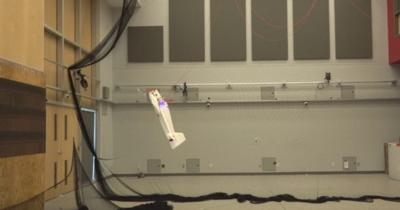Thu, Sep 07, 2017
Uses Microspines To Attach To Rough Surfaces
One of the big advantages to multi-rotor drones is their ability to take off and land vertically. But even a small landing spot might not always be available if needed. Enter the Multimodal Autonomous Drone (S-MAD) developed by researchers at the University of Sherbrooke in Canada.

S-MAD is a fixed-wing drone with the ability to land on a vertical surface like a wall or tree and stay there. To develop the technique, engineers studied how birds take off and land and installed similar mechanisms on the aircraft. They have achieved a 100 percent success rate for landing on vertical surfaces, according to a report appearing on Engadget.
According to an excerpt from the abstract of a scholarly paper on the Createk Design Lab YouTube site, the company says the S-MAD "uses a thrust-assisted pitch-up maneuver to slow down rapidly before touchdown. Microspines are used to cling to rough walls, while strictly onboard sensing is used for control. The effect of thrust on the suspension’s landing envelope is analyzed and a simple vertical velocity controller is proposed to create smooth and robust descents towards a wall. Multiple landings are performed over a range of flight conditions."
In its YouTube video, Createk says the aircraft could have applications such as monitoring areas hit by earthquakes, as well as the inspection of buildings, bridges and other infrastructure.
To land, the aircraft uses sensors to detect the wall, and then executes a rapid pitch-up maneuver to present the microspines to the landing surface. Power is added on final approach to maintain vertical speed and pitch angle. The company says over 30,000 simulations were run to perfect the technique.
To take off, the S-MAD develops enough power to hang from its prop while the microspine feet disengage, and then return the aircraft to a horizontal flight profile.
Createk and the university are continuing to refine the aircraft, and no commercial launch has been discussed.
(Image from YouTube video)
More News
From 2023 (YouTube Version): Legacy of a Titan Robert (Bob) Anderson Hoover was a fighter pilot, test pilot, flight instructor, and air show superstar. More so, Bob Hoover was an i>[...]
Get The Latest in Aviation News NOW on Instagram Are you on Instagram yet? It's been around for a few years, quietly picking up traction mostly thanks to everybody's new obsession >[...]
Aero Linx: B-52H Stratofortress The B-52H Stratofortress is a long-range, heavy bomber that can perform a variety of missions. The bomber is capable of flying at high subsonic spee>[...]
Altimeter Setting The barometric pressure reading used to adjust a pressure altimeter for variations in existing atmospheric pressure or to the standard altimeter setting (29.92).>[...]
"Knowing that we play an active part in bettering people's lives is extremely rewarding. My team and I are very thankful for the opportunity to be here and to help in any way we ca>[...]
 Classic Aero-TV: Remembering Bob Hoover
Classic Aero-TV: Remembering Bob Hoover ANN FAQ: Follow Us On Instagram!
ANN FAQ: Follow Us On Instagram! ANN's Daily Aero-Linx (05.15.24)
ANN's Daily Aero-Linx (05.15.24) ANN's Daily Aero-Term (05.15.24):Altimeter Setting
ANN's Daily Aero-Term (05.15.24):Altimeter Setting Aero-News: Quote of the Day (05.16.24)
Aero-News: Quote of the Day (05.16.24)



